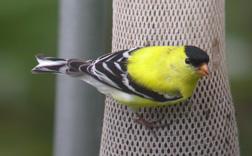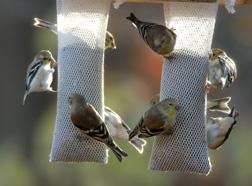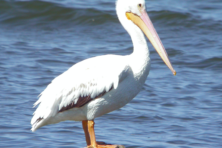The American Goldfinch
- Share
- Tweet
- Pin
- Share

A male American Goldfinch in winter eating seeds of a Tithonia flower. Photo by Roy Lukes.
Let the winter snow begin to fly and surely someone will report a large flock of drab-colored warblers at their feeders.
One of summer’s most conspicuous and beautiful birds of our country, a regular showpiece, the American Goldfinch, has now turned to soft shades of olive-yellow, tan and brown and, to the untrained eye, might be mistaken for some of the usually somber-colored warblers. To see a flock of warblers this far north in December is virtually impossible. Furthermore their beaks are very thin and pointed in comparison to the Goldfinch’s short and stout seed-cracking bill. Unlike the brilliant yellow of the male Goldfinch in summer, the female’s olive-tan plumage is pretty much the same year-round.
The distlefink, or thistle finch in the German language, is a stylized Goldfinch and has been the good luck bird of the Pennsylvania Dutch for many years. This sign contains the heart for love, the tulip for birth, and the thistle seed for the birds’ food. I too look at the Goldfinch as my good luck bird in that it sparked my interest in birds when I was just a child. Our personal name for the bird then, and one commonly used by many people, was the wild canary.
My brothers and I didn’t have to go any farther from our back door in Kewaunee in summer than our large garden to the west of our home. There, as was typical of many of the Bohemian families of that area, my folks grew a large patch of poppy seed plants. The seeds were meticulously harvested at the end of the growing season and my mother used the dried and carefully stored seeds in her ambrosial Czech cooking. So help me I believe my three brothers, sister and I may have been weaned on poppy seed kolaches!

The male American Goldfinch in his bright yellow breeding color of summer. Photo by Roy Lukes.
It so happens that poppy seeds, along with many other kinds of wild seeds, are highly attractive to the wild “canaries.” I can remember my dad fastening a stuffed Great-horned Owl, which he borrowed from his friend Henry Stansky, on top of a stepladder placed in the middle of the poppy seed patch. When that didn’t keep the Goldfinches at bay my brothers and I had to take turns on many summer days scaring the Goldfinches away from the prized poppy seed plants when we would much rather have been with our pals swimming or playing ball.
Another Goldfinch-like bird which fascinated my brothers and me, perhaps from the toddler stage onward, was a caged Canary owned by my Grandpa and Grandma Lukes who lived downstairs from our living quarters. The beautiful domed cage of the Canary stood on a shelf in their east kitchen window, and I especially recall how grandma would carefully reach into the cage each morning, catch the bird and then give it a bath while holding it in her hand. She had a small sauce dish filled with warm water placed on the kitchen table and, using a small white cloth, ever so carefully washed the bird all the while speaking gently to the prized pet. We especially enjoyed watching the thoroughly soaked little bird vigorously shake and preen itself once it was returned to the cage. How we also waited for grandma to get out her crank-operated egg beater, turn it rapidly and magically get the Canary to virtually sing its heart out. How we loved that little bird!
The American Goldfinch, which is ranked number 14 among the 188 native bird species reported in Wisconsin during the popular Christmas Bird Counts, is thought to be wintering farther north than in the past primarily due to the increasingly large number of people including “Niger” seeds, or thistle seeds, in the bird food they place out. These birds of untiring activity, cheerful, high spirited, care-free-appearing, always reflecting happiness, consume a large number of different seeds in their annual diets. Their young in the nest are fed virtually nothing but seeds, especially those of various thistles and milkweed plants simply because the adult birds have used primarily thistle down, plus cattail down for example, in lining their nest. It’s ideal too in that the ripe thistle seeds are so abundant during that season when most other birds have completed their nesting.

A group of American goldfinches feasting on Nyger thistle seeds. Photo by Roy Lukes.
This popular little bird flies an undulating wave-like course, almost as though riding the waves of a stormy sea, and at each peak the male utters its four syllable high-pitched “per-CHICK-o-ree” song. Learn to recognize this wonderful song and hopefully thereafter it will help you immediately identify the beautiful flier. Both the male with his singing and the female with her sweet chips and calls are very musical. Bradford Torrey (1885), famous student and writer about birds, wrote, “To see him then, hovering and singing – or, better still, to see the devoted pair hovering together, billing and singing, is enough to do even a cynic good.”
The fact that the American Goldfinch is the state bird of Iowa, New Jersey and Washington surely makes it an “ocean to ocean” bird. Look at the distribution map of this bird in a good field guide and you will be amazed at its extensive nesting range, well into Canada and even Alaska. My brother Richard and his wife, living in New Mexico, have Lesser Goldfinches coming to their yard to feed. This bird’s range, limited to the southwestern states, is quite small as is that of another western species, even “lesser” than the Lesser Goldfinch, the Lawrence’s Goldfinch.
We haven’t reached the point of venturing a guess as to which of several bird species from the North we can expect to winter here. It may come to pass when you study the many birds at your feeders to see three species feasting together, all having traits in common – gathering in flocks, restless fliers from place to place, and giving their character vocalizations while in flight. You guessed them, the American Goldfinch, the Pine Siskin and the Common Redpoll.
Prepare to help with your area Christmas Bird Count and hopefully these cheerful and tiny “distelfinks,” full of heart and song, will help you to more easily endure the winter.


